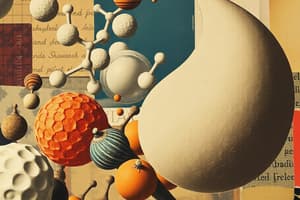Podcast
Questions and Answers
Which of the following is true about carbohydrates?
Which of the following is true about carbohydrates?
- Carbohydrates make up the majority of our body weight
- Carbohydrates are insoluble in water
- Carbohydrates are composed of carbon, hydrogen, and oxygen in a ratio of 2:1:1 (correct)
- Carbohydrates can only be simple sugars
What is the most common form of glucose in our bodies?
What is the most common form of glucose in our bodies?
- Sucrose
- Dextrose (correct)
- Glucose
- Fructose
How are monosaccharides linked to form disaccharides?
How are monosaccharides linked to form disaccharides?
- Through glycosidic links (correct)
- Through dehydration synthesis
- Through peptide bonds
- Through hydrolysis
Which of the following is true about lipids?
Which of the following is true about lipids?
What is the most common type of lipid?
What is the most common type of lipid?
What are triglycerides composed of?
What are triglycerides composed of?
Which fatty acid has the highest melting point?
Which fatty acid has the highest melting point?
Which of the following is true about carbohydrates?
Which of the following is true about carbohydrates?
How are disaccharides broken down into monosaccharides?
How are disaccharides broken down into monosaccharides?
Which of the following polysaccharides have both 1,4 and 1,6 glycosidic links?
Which of the following polysaccharides have both 1,4 and 1,6 glycosidic links?
Which of the following is true about phospholipids?
Which of the following is true about phospholipids?
Which of the following is true about fatty acids?
Which of the following is true about fatty acids?
Which of the following is true about triglycerides?
Which of the following is true about triglycerides?
Which of the following is true about fatty acid melting points?
Which of the following is true about fatty acid melting points?
Flashcards are hidden until you start studying
Study Notes
Carbohydrates
- Carbohydrates are organic compounds mainly composed of carbon, hydrogen, and oxygen.
- The most common form of glucose in the body is D-glucose, often referred to as blood sugar.
- Monosaccharides link to form disaccharides through a dehydration reaction, which involves the removal of a water molecule, creating a glycosidic bond.
- Disaccharides are broken down into monosaccharides via hydrolysis, where a water molecule is added to break the glycosidic bond.
Lipids
- Lipids are a diverse group of hydrophobic molecules, primarily comprised of fats, oils, waxes, and steroids.
- The most common type of lipid is triglycerides, which are primarily used for energy storage.
- Triglycerides are composed of one glycerol molecule and three fatty acids.
- Saturated fatty acids typically have the highest melting points due to their straight-chain structure, allowing for tighter packing.
Polysaccharides
- Polysaccharides can have both 1,4 and 1,6 glycosidic links; examples include amylopectin and glycogen, which are forms of stored glucose in plants and animals, respectively.
Phospholipids
- Phospholipids are essential components of cell membranes, consisting of a hydrophilic phosphate head and two hydrophobic fatty acid tails, allowing for a bilayer structure.
Fatty Acids and Triglycerides
- Fatty acids can be classified as saturated or unsaturated, with unsaturated fatty acids containing one or more double bonds.
- Triglycerides are characterized by their fatty acid composition, which influences their physical properties, such as melting point.
- The melting points of fatty acids correlate with their saturation; unsaturated fatty acids have lower melting points due to the presence of double bonds which create kinks in their structure.
Studying That Suits You
Use AI to generate personalized quizzes and flashcards to suit your learning preferences.




